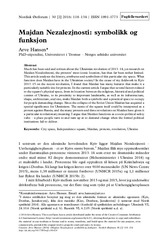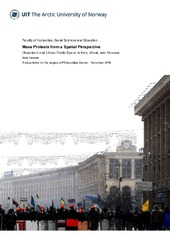Blar i forfatter "Hansen, Arve"
-
Majdan 2013–2014: Plassen, protestene, drivkreftene.
Hansen, Arve (Master thesis; Mastergradsoppgave, 2015-05-13)This thesis examines the Ukrainian revolution (2013-2014) in Kyiv: Where did the discontent come from? What functions did the Maidan (Independence Square) have? What motivated and organised the protesters? What was behind the violence? Ukraine is more diverse than often presented by the media. Discontent comes from two main problems: poor economy and a corrupt elite. Maidan’s physical attributes and ... -
Majdan Nezalezjnosti: symbolikk og funksjon
Hansen, Arve (Journal article; Tidsskriftartikkel; Peer reviewed, 2016)Much has been said and written about the Ukrainian revolution of 2013–14, yet research on Maidan Nezalezhnosti, the protests’ most iconic location, has thus far been rather limited. This article analyses the history, attributes and symbolism of this particular city space. What function does Maidan have in the Ukrainian society? In the cause of my fieldwork in Kyiv 2013–15 on the recent revolution, ... -
Mass Protests from a Spatial Perspective: Discontent and Urban Public Space in Kyiv, Minsk, and Moscow
Hansen, Arve (Doctoral thesis; Doktorgradsavhandling, 2020-03-17)Mass protests have been an important part of the political environment in Eastern Europe for more than a century. Since the Russian revolutions of 1905 and 1917, people have turned to urban spaces to make their opinions heard and to demand change, with varying degrees of success. This was most notably the case during the 1960s; and from the beginning of the end of the Soviet Union in the late 1980s, ... -
Public space in the Soviet city: A spatial perspective on mass protests in Minsk
Hansen, Arve (Journal article; Tidsskriftartikkel; Peer reviewed, 2017)In many capitals, the central public square is the place where people go en masse when they wish to voice their discontent. The squares used for such collective actions are diverse. Each square has its unique combination of symbols and history; they are used in different ways by the public; and they often have distinct physical characteristics. Yet, in social sciences, when determining what makes ...


 English
English norsk
norsk


